Welcome to our exploration of the enchanting world of castles in Cork, Ireland!
In this blog post, we invite you on a journey through history and architectural marvels as we unveil a curated list of the best castles in Cork Ireland. From ancient strongholds to medieval wonders, Cork’s landscape is adorned with these timeless structures, each narrating tales of bygone eras.
Prepare to be captivated by these magnificent castles’ grandeur and historical significance, offering a glimpse into Ireland’s rich heritage.
But that’s not all – as a bonus, we’ll also provide you with a list of top destinations in Cork, ensuring your adventure extends beyond the castle walls.
Join us on this virtual expedition through Cork’s captivating castles and scenic wonders. In this region, history and beauty seamlessly intertwine.
Table of Contents
Top Castles in Cork Ireland
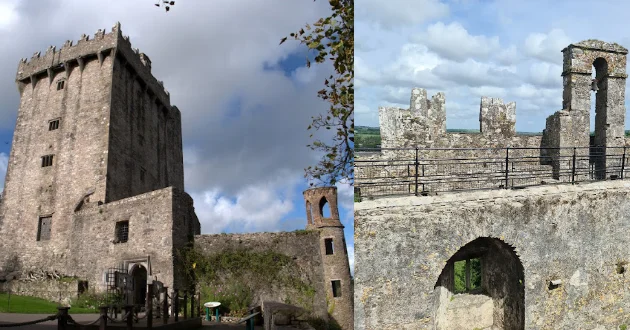
1. Blarney Castle Cork
Blarney Castle, a majestic tower house in Ireland’s landscape, is a testament to centuries of history and architectural prowess.
Constructed by Gaelic lords and the Anglo-Irish between the 15th and 17th centuries, this remarkable fortress boasts an unusual grandeur with its two distinct towers, the second added in the 1500s.
The 18-foot-thick walls, strategically sloping inwards, contribute to stability and serve as a formidable defence mechanism. Intriguingly, the castle is renowned for the legendary Blarney Stone, believed to endow eloquence upon those who kiss it.
Steeped in folklore, Blarney Castle unfolds tales of medieval resilience, mystical origins, and the enduring charm of Ireland’s historic past.
For more information, visit Blarney Castle’s Website.
2. Barryscourt Castle Cork
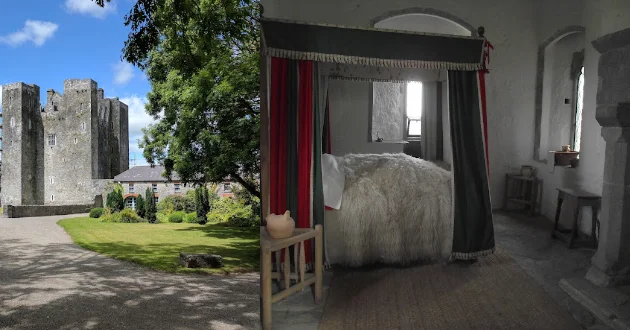
Barryscourt Castle, situated in Carrigtwohill, Co Cork, is a captivating testament to Ireland’s medieval heritage. Once the stronghold of the influential Anglo-Norman Barry family, this meticulously restored Tower House dates between 1392 and 1420.
The castle boasts a formidable outer bawn wall and well-preserved corner towers, with a unique feature—a dungeon on the ground floor accessible through a ‘drop-hole’ from the second floor.
Intriguingly entwined with Irish history, the Barrys supported the Fitzgeralds of Desmond during sixteenth-century rebellions and defended their fortress during the seventeenth-century Irish Confederate War.
Cannonball scars on the entrance wall vividly narrate this tumultuous past. Extensive restoration has brought the Main Hall, Great Hall, and the enchanting sixteenth-century herb and knot garden back to life, preserving the legacy of Barryscourt Castle.
For more information, visit the Barryscourt Castle Web Page.
3. Blackrock Castle Cork
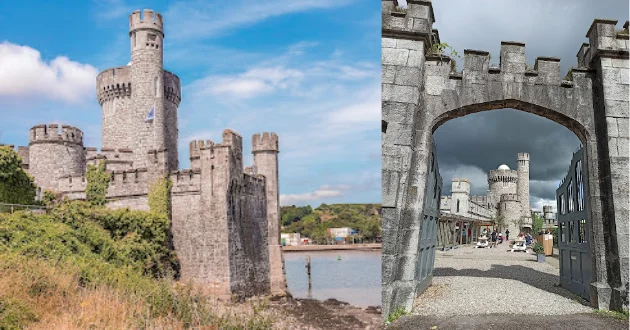
Blackrock Castle, nestled along the scenic River Lee, is a historic gem just 2 km from Cork city centre. Originally erected in the 16th century as a coastal defence fortification to shield Cork Harbour, it evolved through centuries, surviving fires and renovations.
Rescued from private hands in 2001, the castle underwent a transformative redevelopment, giving rise to the “Cosmos at the Castle” project. Since its opening in 2007, this venerable site has flourished into a dynamic hub for scientific exploration and public engagement.
The castle now houses an interactive astronomy centre, inviting visitors to embark on a fascinating “tour of the universe” and witness innovative research conducted by astronomical experts from the Cork Institute of Technology.
While visiting, make sure to stop off and dine in the Castle Cafe Restaurant which is one of my top restaurants for brunch in Cork; I would highly recommend it.
For more information, visit the Blackrock Castle website.
4. Desmond Castle Cork
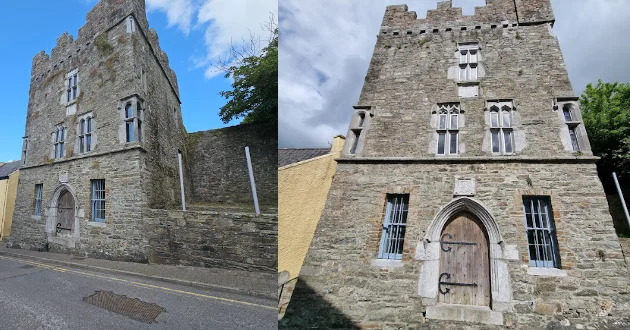
Desmond Castle, a captivating landmark in Kinsale with origins dating back to 1500, is a testament to Ireland’s rich history. This classic urban tower house, featuring a three-storey keep and rear storehouses, was commissioned by Maurice Bacach Fitzgerald, the Earl of Desmond, serving initially as the town’s customs house.
Evolving through the centuries, it transformed into a prison during the seventeenth and eighteenth centuries, earning the local name “French Prison” due to its diverse inmate population. Witness to significant events like the Battle of Kinsale and the Great Famine, the castle has played various roles.
It hosted Gaelic League meetings in the twentieth century and housed a thriving undertaking business. Today, Desmond Castle stands proudly as a National Monument, echoing centuries of colourful and multifaceted history.
For more information, visit the Desmond Castle webpage.
5. Kanturk Castle Cork
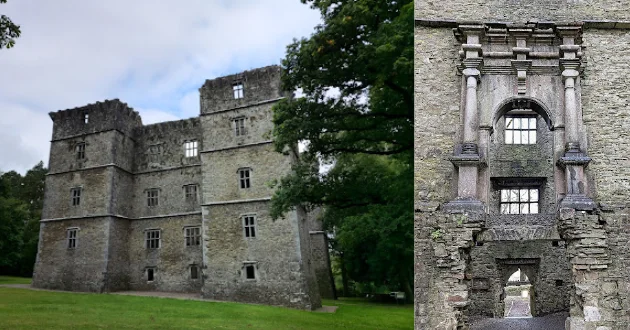
Kanturk Castle, perched on the outskirts of Kanturk in North County Cork, Ireland, is a captivating blend of traditional Irish tower-house and Tudor architecture.
Built around 1601 for MacDonogh MacCarthy, Lord of Duhallow, the castle’s rectangular structure boasts massive square towers, Renaissance doorways, and pointed arches. Despite being intended as a defence against English forces, construction ceased under the scrutiny of the Privy Council.
Today, Kanturk Castle is a historic ruin with four main storeys and five towers, preserving its unique architectural features.
Donated to the National Trust in 1900, its condition remains unchanged, reflecting its intriguing role as the 9th property acquired by the Trust and a significant part of Ireland’s heritage.
For more information, visit the Kanturk Castle website.
6. Belvelly Castle Cork
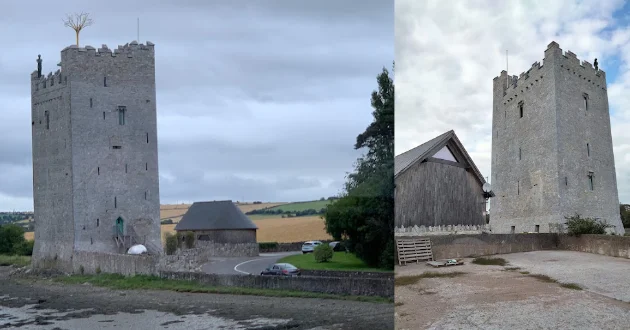
Belvelly Castle, a magnificent 14th or 15th-century tower house in County Cork, Ireland, stands proudly near the village of Belvelly.
Initially constructed by the Anglo-Norman Hodnett family, the castle later transitioned through the hands of the De la Roch (Roche) and De Barra (Barry) families.
Steeped in history, it witnessed occupation by Walter Raleigh in the 16th century. It played a role in the Irish Confederate Wars under Roger Boyle, 1st Earl of Orrery.
Positioned by the bridge connecting Great Island to Fota Island, Belvelly Castle is a breathtaking backdrop to the village on one side of this historical link and just a short drive from the history town of Cobh in County Cork.
Following a meticulous restoration, completed in 2018 with added artworks, the castle now stands as a beautifully revived testament to Ireland’s rich heritage.
For more information, visit the Belvely Castle website.
7. Macroom Castle Cork
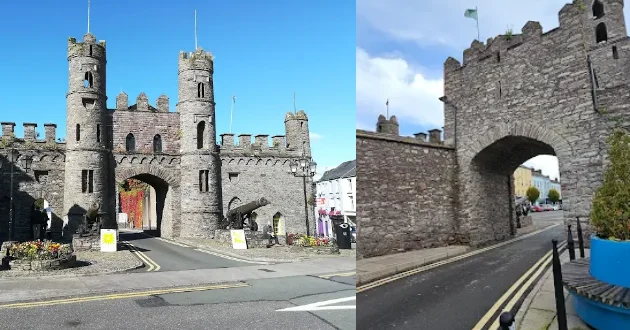
Macroom Castle, situated in the heart of Macroom town, embodies centuries of history as the former stronghold of the Lords of Muskerry.
Resilient through changing ownership, sieges, and fires, the castle, with surviving remnants like the medieval-romantic gatehouse and a towered ruin, showcases its enduring legacy.
Once a residence and fortress, the castle’s main block, dominating the town’s skyline, was sadly demolished in 1967, replaced by Bishop McEgan College’s modern wing.
Originating in the 12th century, Macroom Castle, owned by the MacCarthys and pivotal in historical events, faced confiscation, restoration, and, tragically, burning during the Irish Civil War in 1922.
Now, its surviving structures stand as silent witnesses to a complex and storied past.
8. Kilbrittain Castle Cork
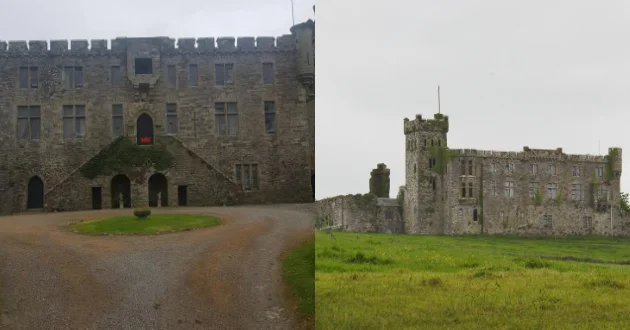
Perched atop a rise with sweeping views, Kilbrittain Castle proudly claims the title of Ireland’s oldest inhabited castle, dating back to 1035.
Once held by the O’Mahonys and later enlarged by the de Courcys, this historic fortress saw a pivotal shift to the MacCarthys in the fifteenth century.
The castle’s circular tower, adorned with tapering walls and intriguing Latin inscriptions, is a testament to this era. Rich in history, Kilbrittain Castle surrendered during the Confederate period, was granted to the McCarthys, and later passed to the Stawell family.
Despite transformations, including a Georgian house and Gothic Revival embellishments, the castle suffered destruction during “The Troubles” in 1920.
Parts were dismantled, but a wing was meticulously restored in 1968-69, preserving Kilbrittain Castle’s architectural charm and historical allure.
For more information, visit the Kilbrittan Castle webpage.
9. Liscarroll Castle Cork
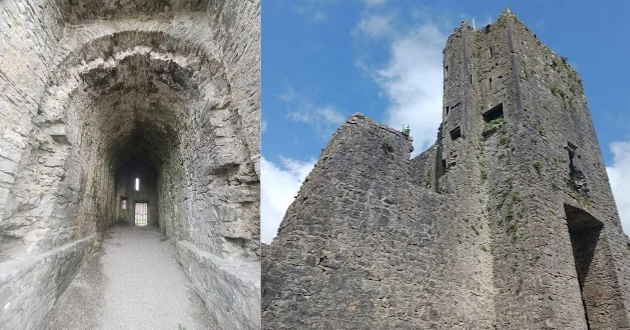
Liscarroll Castle, a formidable 13th-century fortress in North Cork, is part of a defensive line against Gaelic clan incursions from the west. Devoid of a central keep, the castle relies on robust curtain walls and circular corner towers featuring sloped external bases and a protective moat.
Battlements with arrow loops adorn the walls, providing strategic vantage points. The southeast tower conceals a historic well. The main entrance, a barrel-vaulted passage in the square tower, underwent substantial 15th-century enhancements.
Linked to the Norman de Barry family, the castle witnessed ownership shifts, including Sir Philip Perceval’s claim in the 17th century. A participant in 1640s conflicts, the castle withstood a breach in the western wall during a 1650 artillery attack by Parliamentary forces.
After the Cromwellian era, ownership returned to the Percivals, enduring until recently.
10. Mallow Castle Cork
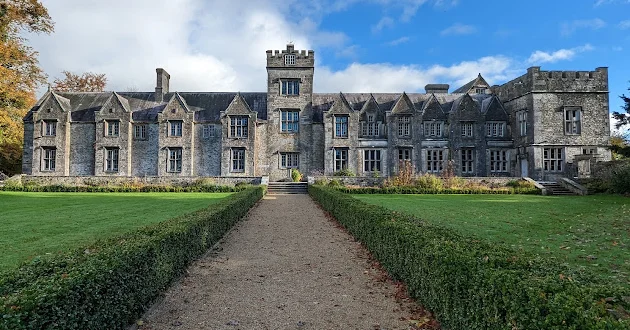
Nestled on a sprawling 33-acre site, Mallow Castle boasts a rich tapestry of history and architecture. Anchored by the remains of a 16th-century fortified house, this early Jacobean gem showcases polygonal towers, high roofs, and mullioned windows.
Adjacent to the aged castle ruins, a grand 19th-century baronial mansion, with roots dating to the 1690s, unfolds a luxurious interior featuring 8 reception rooms, including a music room, billiard room, and library, alongside 12 bedrooms.
Originating from King John’s directives in 1185, passing through the Earls of Desmond and Sir Thomas Norrey, the castle witnessed sieges during the Irish Confederate Wars and the Williamite War.
Designated a National Monument in 1928, the site, now under Cork County Council’s stewardship since 2011, seamlessly weaves together centuries of heritage.
For more information, visit the Mallow Castle webpage.
11. Castlemartyr Castle Cork
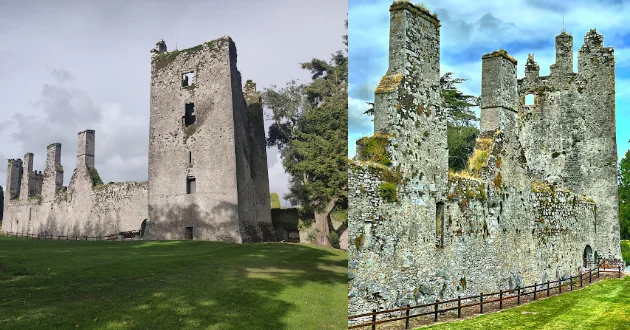
Nestled in Castlemartyr, County Cork, Ireland, Castlemartyr Castle has witnessed centuries of history. Erected in 1420 as the seat for the local seneschal, it faced captures, abandonments, and reconstructions.
Sir Henry Sidney claimed it 1569, and the castle saw strife during the 1640s wars. Ravaged and repaired, it hosted Lord Broghill in the 1650s but succumbed to abandonment after the Williamite capture in 1690.
Transitioning into a farmyard, the castle now shares its grounds with the Castlemartyr Resort, a luxury spa and 5-star hotel since 2007.
Though its interiors are restricted, visitors can explore its captivating ruins within the resort’s embrace.
For more information, visit Castlemartyr Resort’s website.
12. Monkstown Castle Cork
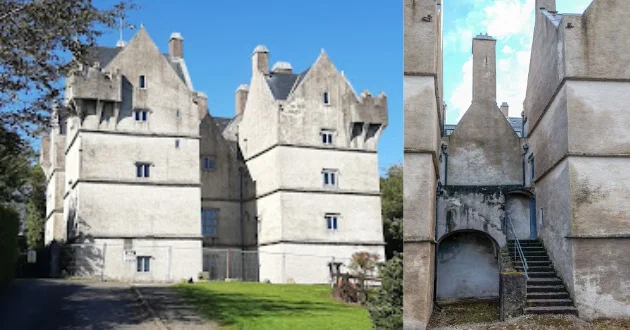
Built in 1636, Monkstown Castle is a detached fortified house overlooking Cork Harbour. This two-stage tower house with attic accommodation features square-plan gabled towers at each corner, adorned with stepped crenellations and ashlar stone details.
The rendered walls, supported by ashlar stone corbels, house square-headed openings in various arrangements, reflecting seventeenth-century defensive architecture.
Initially constructed by Anastacia Archdeacon, it suffered damage from her husband’s cannon fire, mistaken for an occupying force.
Throughout history, it changed hands, including owners like Captain Thomas Plunkett and Archbishop Michael Boyle.
Functioning as a military barracks and later a clubhouse, Monkstown Castle retains its historic character, showcasing the architectural essence of its time.
For more information, visit the Monkstown Castle website.
Recommended Cork Attractions
As you explore the historic castles in Cork, Ireland, we’ve gone above and beyond by providing you with an array of additional attractions to enhance your journey.
Beyond the medieval fortresses and ancient ruins, Cork boasts a diverse range of destinations that promise to elevate your overall experience.
Immerse yourself in the vibrant culture of Cork City, where bustling markets, charming streets, and lively pubs await. Don’t miss the scenic beauty of places like Fota House and Gardens or the tranquillity of Bantry House and Gardens.
For a touch of adventure, consider visiting Camden Fort Meagher or the picturesque Annes Grove Gardens.
Whether you’re drawn to natural landscapes, architectural wonders, or cultural hotspots, our bonus list of attractions ensures that your Cork adventure extends far beyond the castle grounds. Get ready to uncover the hidden gems and must-visit spots that make Cork a truly captivating destination.
Don’t forget to dine in one of the many Best Restaurants in Cork City while visiting or pop over the Cork’s best indoor market, the Marina Market Cork.
1. Cork City Hall
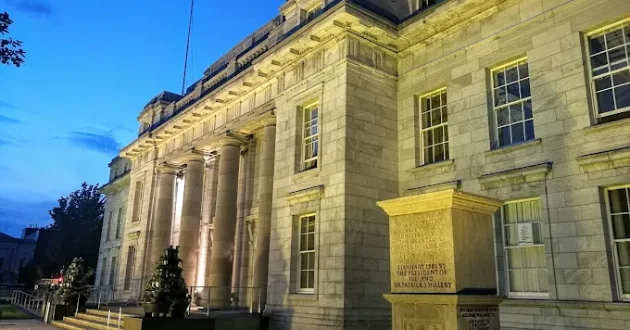
Cork City Hall, or Halla na Cathrach in Irish, is a prominent civic landmark in Cork, Ireland. Originally commissioned to replace the old City Hall destroyed in 1920, the current building, designed by Alfred Jones and Stephen Kelly, was opened by Éamon de Valera in 1936.
This monumental structure, funded by the British Government as a gesture of reconciliation, reflects classical architectural elegance. Unlike its predecessor, the new City Hall features mosaics of the city arms in the entrance hall and on the tympanum above the concert hall stage.
A 2007 extension by ABK Architects further enhances its historical and architectural significance, solidifying its role as the administrative heart of Cork City Council.
2. Cork City Gaol
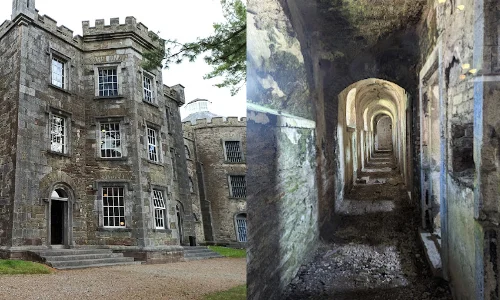
Cork City Gaol, now a museum, is a testament to Ireland’s penal history. Commissioned in 1806 to replace an overcrowded North Gate Bridge gaol, it was designed by William Robertson and built by the Deane family.
Opening in 1824, it initially housed male and female offenders within the city limits. By 1878, it became a women’s gaol, serving city and county.
It hosted notable prisoners throughout history, including Fenian Brian Dillon and revolutionary Constance Markievicz. During the Irish War of Independence and the Civil War, it held Republican prisoners.
In 1923, a daring escape marked its closure, becoming a radio station and eventually transforming into a museum.
For more information, visit the Cork City Gaol website.
3. Fota House And Gardens
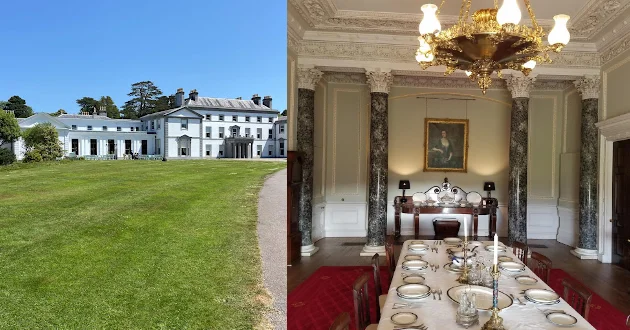
Fota House and Gardens, situated on an idyllic wooded island in Cork Harbour, encapsulate the historical and horticultural legacy of John Smith-Barry.
Originally a hunting lodge, Smith-Barry commissioned architects Richard and William Vitruvius Morrison in the 19th century to transform it into the neoclassical masterpiece we see today.
The central hall, adorned with a Roman Doric portico and Grecian columnar screens, is one of Ireland’s finest interiors. The estate, renowned for its microclimate, harbours a diverse collection of rare plants.
Acquired by University College Cork in 1975, ongoing restoration efforts and vibrant activities preserve Fota’s rich heritage, making it a haven for history, horticulture, and contemporary appreciation.
For more information, visit the Fota House and Gardens website.
4. Doneraile Court Cork
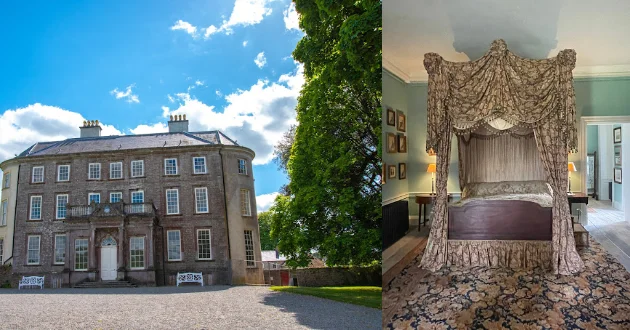
Nestled along the serene banks of the Awbeg River in north Co. Cork, Doneraile Estate boasts the magnificent Doneraile Court as its centrepiece.
The house exudes imposing charm, constructed in the 1720s by Arthur St. Leger, the first Viscount Doneraile, and later enhanced in the 19th century.
The 19th-century kitchen wing now houses the Doneraile Court tearooms, offering a delightful start or conclusion to your visit. Once the residence of the St. Leger family until 1969, the estate transitioned through various hands, finding care under the Irish Georgian Society and later the Office of Public Works in 1994.
Steeped in literary heritage, the estate and its village connect to luminaries like Edmund Spenser, Elizabeth Bowen, and Canon Sheehan.
Visit the Doneraile Estate website for more information.
5. Annes Grove, Co Cork
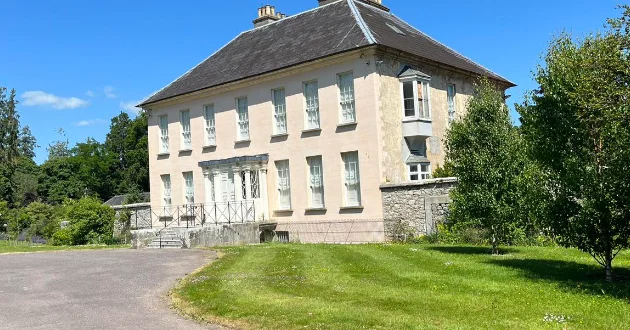
Annes Grove Gardens, nestled near Castletownroche in Co. Cork, Ireland, unfold a botanical tale rooted in history. Once the abode of the Annesley family since the 1600s, this enchanting estate transitioned to public care under the Office of Public Works in 2015.
Under Richard Arthur Grove Annesley’s stewardship from 1892, the gardens flourished in the Robinsonian style during the early 1900s. Guided by a passion for exotic flora, Annesley sponsored plant-hunting expeditions to distant lands.
The result is a mesmerizing collection featuring splendid specimens like Cornus causa, Embothrium, Eucryphia, and Hoheria.
Currently undergoing restoration, Annes Grove Gardens are set to reopen in 2022, inviting visitors into a living tapestry of botanical wonders.
Visit the Annes Grove Gardens website for more information.
6. Bantry House & Gardens
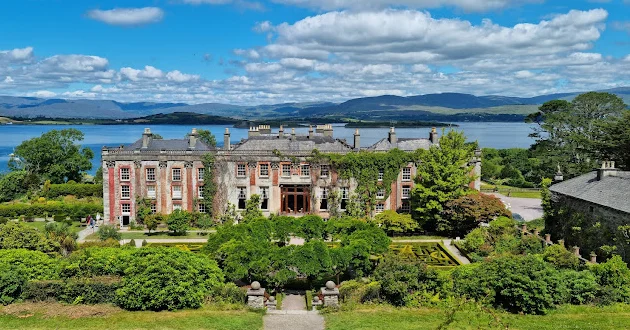
Bantry House, named initially ‘Blackrock,’ has graced the shores of Bantry Bay since its construction around 1710. Acquired by Councillor Richard White in 1750, it transformed into a family seat with extensive gardens developed by the 2nd Earl of Bantry.
The estate, covering around 80,000 acres in the 1780s, became public in 1946. Country House Rescue featured it in 2012. The gardens, featuring seven terraces with a stunning backdrop of azaleas and rhododendrons, underwent restoration efforts in 1997.
Bantry House offers a glimpse into history, hosting an exhibition on the United Irishmen Rebellion. Beyond its historical significance, it remains a cherished family home, welcoming visitors to explore its grounds.
Visit the Bantry House website for more information.
7. Camden Fort Meagher, Crosshaven
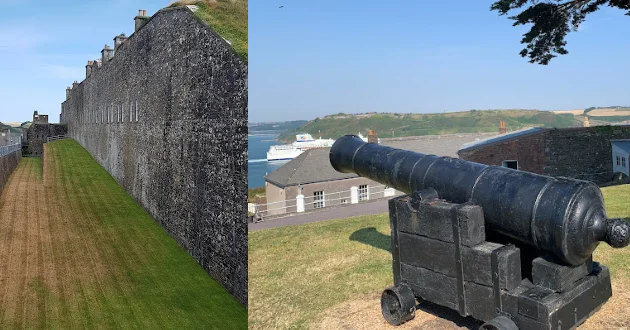
Camden Fort Meagher, situated near Crosshaven, County Cork, Ireland, is a coastal defence fortification with a rich history dating back to the 16th century.
Initially named Fort Camden, it served the British Armed Forces until 1938, when it was handed over to the Irish Defence Forces and other Treaty Port installations.
Renamed Fort Meagher in honour of Thomas Francis Meagher, it continued as an Irish military installation until 1989. Cork County Council took over in 1989, and after community-driven restoration efforts starting in 2010, it is now open seasonally to visitors.
The fort showcases diverse exhibits, including the world’s first “practical guided weapon,” the Brennan Torpedo, making it a captivating heritage and tourism site.
Visit Camden Fort Meagher’s website for more information.
8. Charles Fort, Kinsale
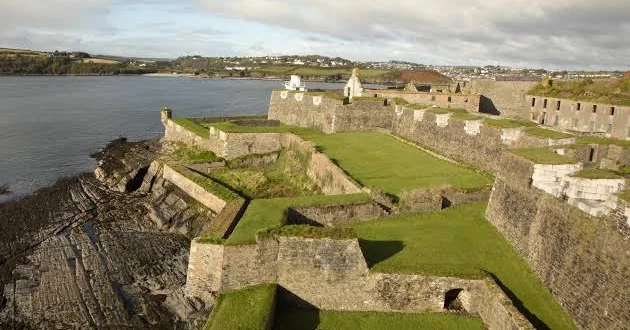
Standing proudly at the southern end of Summer Cove in Kinsale, County Cork, Ireland, Charles Fort is a remarkable trace of Italienne fortification.
Completed in 1682, it replaced the ruins of Barry Óg Castle and earned its name from Charles II. Sir William Robinson designed this bastioned fort showcasing five bastions, with “Kinsale” and “Charles” dominating the seaward defences.
Charles Fort witnessed history throughout its two centuries as a British Army barracks, including the 13-day siege in 1690 during the Williamite War.
The fort, operated by Heritage Ireland, became a heritage tourism site, preserving its architectural significance and the stories embedded in its walls. Make sure to check out some of the Best Restaurants in Kinsale while visiting the Fort.
Visit the Charles Fort website for more information.
9. Spike Island, Cobh
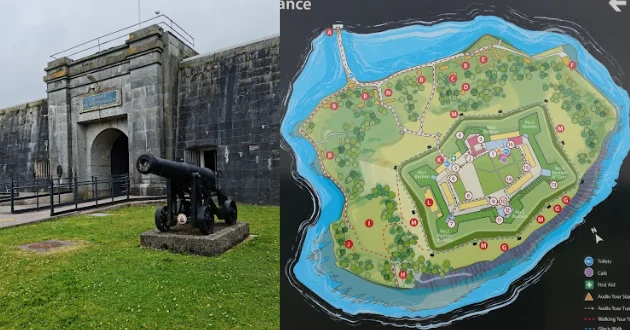
Spike Island, an illustrious 103-acre island in Cork Harbour, Ireland, has evolved from a 7th-century monastic site to a multifaceted bastion fort known as Fort Mitchel.
In 2015, it underwent a transformative journey to become a premier heritage tourist attraction. With a captivating history, including roles in defence, imprisonment, and military activities, Spike Island offers visitors an immersive exploration of Ireland’s rich past.
This award-winning destination received the prestigious ‘Europe’s Leading Tourist Attraction’ title at the 2017 World Travel Awards. The island’s strategic location and substantial investments in exhibits and visitor spaces have made it a must-visit site, attracting over 81,000 visitors in 2019.
Spike Island is a testament to Ireland’s heritage, now celebrated as an engaging and award-winning cultural destination. While visiting Spike it’s always great to grab a bite to eat in Cobh before or after the boat over to the Island. Read my Best Restaurants in Cobh guide for all the best eating spots.
Visit the Spike Island website for more information.
